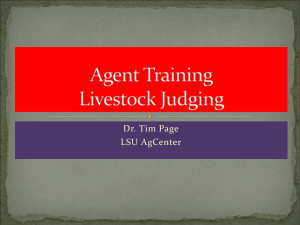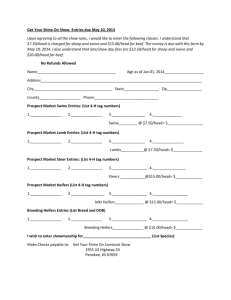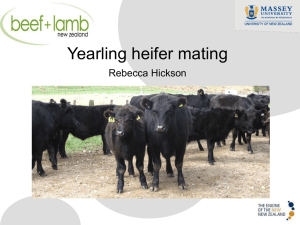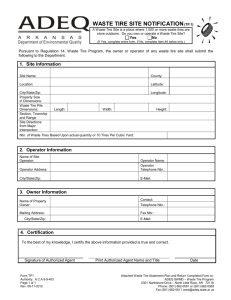May Newsletter - u.osu.edu.chicken
advertisement
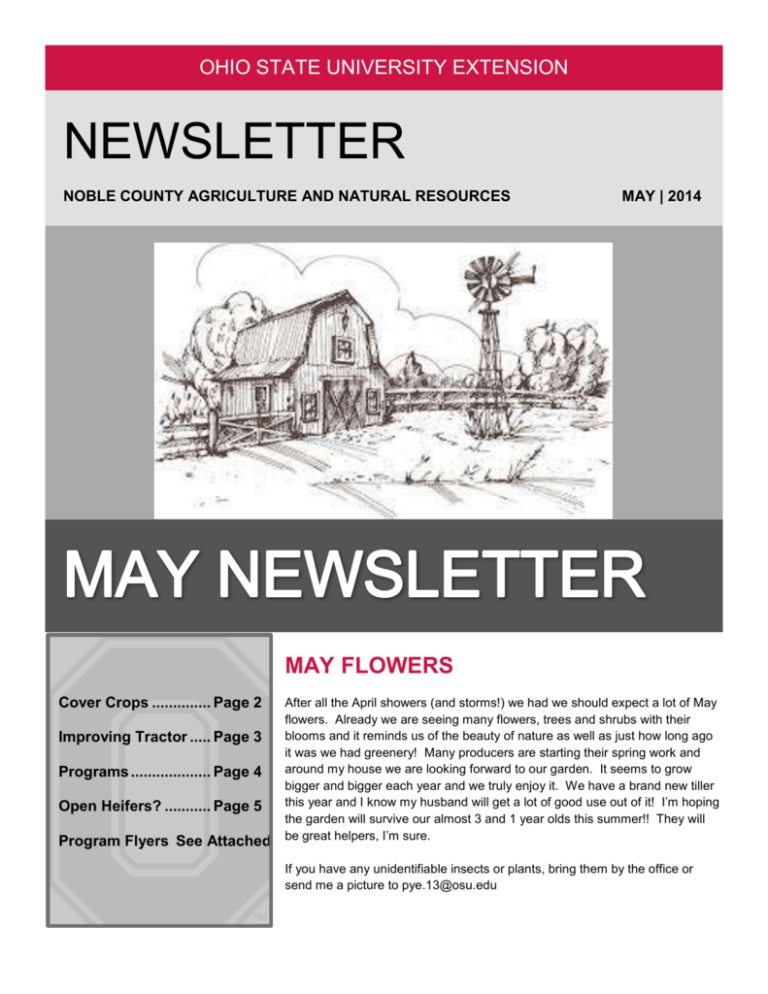
OHIO STATE UNIVERSITY EXTENSION NEWSLETTER NOBLE COUNTY AGRICULTURE AND NATURAL RESOURCES MAY | 2014 MAY FLOWERS Cover Crops .............. Page 2 Improving Tractor ..... Page 3 Programs ................... Page 4 Open Heifers? ........... Page 5 Program Flyers See Attached After all the April showers (and storms!) we had we should expect a lot of May flowers. Already we are seeing many flowers, trees and shrubs with their blooms and it reminds us of the beauty of nature as well as just how long ago it was we had greenery! Many producers are starting their spring work and around my house we are looking forward to our garden. It seems to grow bigger and bigger each year and we truly enjoy it. We have a brand new tiller this year and I know my husband will get a lot of good use out of it! I’m hoping the garden will survive our almost 3 and 1 year olds this summer!! They will be great helpers, I’m sure. If you have any unidentifiable insects or plants, bring them by the office or send me a picture to pye.13@osu.edu Cover Crops Are Viable Option for Livestock Supplemental Feed WOOSTER, Ohio — Producers who want to use the cover crops they planted last fall as supplemental feed for their livestock may want to may want to harvest these crops quickly before the plants get too mature and the feed quality declines, says a forage expert from the College of Food, Agricultural, and Environmental Sciences at The Ohio State University. So says Rory Lewandowski, agriculture and natural resources educator for the college’s outreach arm, Ohio State University Extension. Although cover crops are typically planted to control erosion and improve soil structure and health, they can also be a good option as supplemental forage for livestock, he said. “There are a number of dairy farmers who take a cutting off of cover crops that are planted in the fall, like cereal rye and winter wheat, harvest it and use it as a wet forage, and then plant corn for silage,” Lewandowski said. “And warm-season cover crops including clovers, sudangrass, sorghum-sudangrass hybrids or spring-planted radishes used to promote soil health can also be grazed by livestock or mechanically harvested and used as stored forage” However, while cover crops such as cereal rye, triticale and winter wheat can also be used as supplemental forage for livestock, they need to be harvested in a timely fashion for optimal use, he said. “Cereal rye quality declines the most rapidly as the plant enters the reproductive growth stage, and it advances most rapidly from vegetative to reproductive growth compared to the other two forages,” Lewandowski said. “So producers should harvest these crops at boot to very early head stage of maturity.” Producers should harvest these crops as silage or as wrapped forage as the best option for supplemental feed because there typically aren’t many good drying days during spring in the region, he said. “Also, producers who choose to graze cattle on these cover crops should make sure they have enough animals to graze across the field before the crops get too mature and lose quality,” Lewandowski said. “It is also important to give livestock no more than one or two days’ worth of grazing at a time before moving the fence to provide access to another portion of the crops when using strip grazing.” Producers also need to be aware that grazing on spring growth of winter wheat or cereal rye can increase the potential for grass tetany in livestock, particularly in cows still nursing calves less than four months old, he said. “Grass tetany is a potentially fatal nutritional disorder in livestock caused by low blood magnesium levels,” Lewandowski said. “Grass tetany can be prevented by feeding animals that graze in lush, rapidly growing grass pastures a high-magnesium mineral mix starting at least a week or two before spring grazing and continuing throughout the spring grazing period.” A free-choice high-magnesium mix should contain 12-15 percent magnesium from magnesium oxide and can be mixed with a grain or flavoring agent such as molasses to encourage cattle to eat it, he said. The mixture should be fed to cattle daily in 4-ounce portions throughout late spring until forages are more mature and temperatures are warmer, Lewandowski said. Tetany is most likely to be seen in early spring grazing as cool-season grasses and small grains such as wheat and rye are most often low in magnesium and calcium and high in potassium, he said. Signs of grass tetany include muscle twitching in the flank, muscular incoordination, grazing away from the herd, irritability, wide eyes, staring, staggering, collapse, thrashing and coma. It can quickly result in death. May Newsletter 2 AGRICULTURE AND NATURAL RESOURCES Injury Prevention – Tractor Ride Comfort AG S.T.A.T Newsletter Dewey Mann, Research Associate As the ground temperature begins to warm up, preparations for spring planting are well underway. By the time this article goes to press, many farming operations will have already completed maintenance checks on spring planting equipment; meters calibrated, bearings and chains (if equipped) lubricated, planter unit leveled, change oil in the planter tractor, etc. Typically, ‘tire inflation pressure’ only makes the maintenance checklist if the operator has a planter with a ground drive system*. Sure, we might ‘check’ the tire pressure on the planting tractor, but where does our target inflation number come from? Possibly an inflation pressure we have used for years (25PSI), or a number we have heard thrown around the coffee shop. Proper tire inflation pressure can increase productivity, fuel efficiency, and yes, even ride comfort. Common means of suspension on agricultural tractors include (from operator to the ground): seat, cab, axle, and tire suspension. Aside from upgrading to a newer model tractor, the quickest method for influencing ride comfort is to adjust tire inflation pressure (tire suspension). Consulting tire load and inflation tables, from the tire manufacturer, is likely the best source for determining the proper tire inflation pressure. A row crop tractor equipped with 480/80R42 duals (4 tires across the rear axle), and an axle weight of 16,000lbs (4,000lbs per tire), the proper tire inflation pressure would be 12PSI (pounds per square inch). The same concepts also apply for utility or lawn and garden tractors. If a lawn and garden tractor had a rear axle load of 1200lbs (600lbs per tire), and was equipped with 21x8.00-10 NHS tires, the recommended inflation pressure would be 10PSI. ALWAYS consult the tire load and inflation pressure tables, and communicate with your local tire dealer to ensure the proper inflation pressures are being used; and they the tire manufacturer will guarantee the warranty at the selected inflation pressure. *For those not familiar with planting equipment, a ground drive planter transfers power from a ground wheel, through a drive shaft to the planter transmission; if the diameter of the ground drive tire is altered (inflation pressure too high or too low), the planter rate will also be altered (underseeding, or overseeding). Modern planting systems are utilizing hydraulic or electric powered drive systems. Example load and inflation scenarios referenced using: http://www.firestoneag.com/en/tire-info/load-inflation-tables/default.aspx Dewey Mann, research associate for agricultural safety and health, and lecturer for agricultural systems management, can be reached at (614) 292-1952 or mann.309@osu.edu. May Newsletter 3 Program Information Online You can now access information that has been presented at current programs online a week or two after the program has occurred. This mostly includes the PowerPoint’s that were distributed. In some cases, it might not be applicable to post information, especially if the participants have a fee to obtain a large amount of information. You can also view the newsletter online as well as flyers for current programs that are happening in the area. Please be sure to note registration deadlines. Things sometimes come up in between newsletter mailings so check the blog for more information : u.osu.edu/nobleanr/ AGRICULTURE AND NATURAL RESOURCES 2015 Sheep Day Mark your calendar, the 2015 Ohio Sheep Day will be held Saturday, July 11. It is being hosted by Schoolhouse Shropshires, Jim and Denise Percival located at 961 Hoop Rd., Xenia, OH 45385. Registration will begin at 8:00 a.m. This year’s program is being finalized with the focus on programming to increase and improve the productivity and profitability of sheep and other small ruminant operations. Ohio Sheep Day will offer visitors the opportunity to visit a successful sheep farming operation dedicated to sheep production in a profitable way. Sheep farmers and anyone interested in sheep management is cordially invited to attend. Details will be made available on the Sheep Team Web page http://sheep.osu.edu UPCOMING LOCAL PROGRAMS Noble Co. Multi Agency Building Open House – June 13,10a-2p Come take a tour of our new office! Rain Barrel Workshop – June 20, 9a-11a OSU Extension/Noble County SWCD Noble Co. Multi Agency Building Registration limited to 15 Morgan – Noble Pasture Walk Series #2 of 4 – Morgan County August 3 – starting at 6pm There will also be a sprayer nozzle and calibration demonstration Attached Flyers have more detailed information as well as times and registration deadlines. For more information or to register call the office at 732-5681 or email pye.13@osu.edu . May Newsletter 4 AGRICULTURE AND NATURAL RESOURCES Keep or Cull Open Replacements? Glenn Selk, Oklahoma State University Extension For some cow calf operations, the bulls go into the breeding pasture with replacement heifers in mid-April. As the bulls are being removed from the replacement heifers in two months, this would be an ideal time to call and make arrangements with your local veterinarian to have those heifers evaluated for pregnancy after another 60 days. In two months after the breeding season, experienced palpaters should have no difficulty identifying which heifers are pregnant and which heifers are not pregnant (open). Those heifers that are determined to be "open" after this breeding season, should be strong candidates for culling. Culling these heifers immediately after pregnancy checking serves three very useful purposes. 1. Identifying and culling "open" heifers early will remove sub-fertile females from the herd. Lifetime cow studies were conducted at a USDA experiment station in Montana. Over the span of 23 years, 1589 replacement heifers were exposed to bulls. Over that number of years 266 heifers were found to be "open" after their first breeding season. All of these "open" heifers were kept in the herd for an average of about 4 years. From the 1006 opportunities to become pregnant that followed, only 551 calves were produced. In other words, when the heifers that failed to breed in the first breeding season were followed throughout their lifetimes, they averaged a 54.9% yearly calf crop. Despite the fact that reproduction is not a highly heritable trait, it also makes sense to remove this genetic material from the herd so as to not proliferate females that are difficult to get bred. 2. Culling open heifers early will reduce production costs. If the rancher waits until next spring to find out which heifers do not calve, the winter feed expense will still be lost and there will be no calf to help eventually pay the bills. This is money that can better be spent in properly feeding cows that are pregnant and will be producing a salable product at weaning time. 3. Identifying the open heifers shortly (60 days) after the breeding season is over will allow for marketing the heifers while still young enough to go to a feedlot and be fed for the "choice" beef market. The grading change of several years ago had a great impact on the merchandising of culled replacement heifers. "B" maturity carcasses (those estimated to be 30 months of age or older) are much less likely to be graded choice. Therefore, it is imperative to send heifers to the feedlot while they are young enough to be fed for 4 to 5 months and not be near the "B" maturity age group. Certainly the percentage of open heifers will vary from ranch to ranch. Do not be concerned, if after a good heifer development program and adequate breeding season, that you find that 10% of the heifers still are not bred. These are the very heifers that you want to identify early and remove from the herd. Resist the temptation to "roll them over" to a fall-calving herd if they have failed to breed in a spring breeding season. Producers that are buying replacement females (at a quite hefty price) need to be wary of heifers that were exposed to bulls or artificial insemination/clean-up bulls and remain non-pregnant. This is the easiest opportunity to become pregnant that they will have. If they are still open after that first breeding season, they may be infertile at worst, or sub-fertile compared to other heifers. Remember the old Montana data that suggests that they will be 55% calf crop females the rest of their lives. May Newsletter 5 AGRICULTURE AND NATURAL RESOURCES NOBLE COUNTY EXTENSION OFFICE 46049 Marietta Road CALDWELL, OH 43724 Phone 740-732-5681 URL noble.osu.edu CFAES provides research and related educational programs to clientele on a nondiscriminatory basis. For more information: http://go.osu.edu/cfaesdiversity. Gardening season is almost here!
